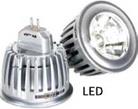Low-Energy Lighting: The Latest Bulb Technologies
![]()
An aversion to fluorescents is understandable because they have been so awful for so long. They didn’t dim easily; they buzzed and gave off weird colors. And sadly, the push to offer CFLs at a price point close to that of a standard incandescent household bulb has given fluorescents a bad name all over again. The color of these cheap CFLs is poor, they burn out prematurely, and they aren’t dimmable. There are much better products on the market. Be prepared to pay more, but they will be worth it. Top – of-the-line screw-in CFLs by manufacturers like MaxLite™ and Earthtronics® (see "Bulb Sources," on p. 154) offer an energy – efficient, dimmable (down to 30%) light source that can be controlled by a standard incandescent dimmer.
A new category of CFL is the GU-24, characterized by a proprietary lamp and socket assembly that cannot be replaced with a standard screw-in incandescent lamp
(although MaxLite makes a screw-in adapter that allows a typical lamp to accept a GU – 24 socket). The GU-24 lamps meet California’s Title 24, which requires that 50% of the wattage in kitchens must come from hardwired high-efficacy sources and 100% of the wattage in the bath must come from high-efficacy sources, unless controlled by a switched motion sensor.
For savvy people everywhere, lighting manufacturers are now offering decorative fixtures in modern and traditional styles that have hardwired fluorescent sources. CFL
Many use the new GU-24 socket and lamp technology, which is no bigger than a standard household bulb and socket assembly. They

 can be installed where there is an existing incandescent fixture and can be dimmed with the existing incandescent dimmer. No special wiring or dimmer is needed.
can be installed where there is an existing incandescent fixture and can be dimmed with the existing incandescent dimmer. No special wiring or dimmer is needed.
COLD CATHODE FLUORESCENT LAMPS
CCFLs are a newer generation of fluorescent lamps. They can look just like regular household bulbs, globe lamps, or flame-tip lamps. They cost more than an incandescent, about $12 each, but save an average of $33 in energy costs over their lifetime. An 8w CCFL produces 40w worth of illumination and lasts 25,000 hours, compared to an incandescent with an average rated lamp life of 750 hours. What makes them better than regular CFLS is their wide variety of color temperatures and that they can dim down a full 90% (CFLs can’t dim that much). Their swirls are thinner, and they’re more widely available than CFLs in low wattages. They are still a bit hard to find; they must be special – ordered through lighting specialty stores or bought online.
In use since the 1960s, LEDs were used as colored indicator lights. About three years ago, manufacturers came up with an LED source with the same color qualities of incandescent light and daylight. These new LEDs use considerably less electricity than standard incandescent sources and last much longer—30,000 to 50,000 hours, while emitting no ultraviolet radiation. Even better, they contain no mercury, as do fluores-
|
|
cents. Companies like Cree Lighting® and Progress Lighting® offer both screw-in and hardwired LED kits as retrofits for existing housings, as well as IC-rated, airtight housings for new construction.







Leave a reply